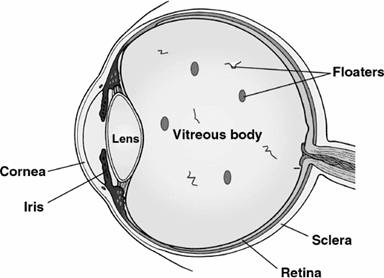
POSTERIOR VITREOUS DETACHMENT (FLASHES AND FLOATERS)
What are flashes and floaters?
Floaters can look like little bugs, stars, threads, or cobwebs. They move when you try to look at them and are most noticeable in bright light.

How do they occur?
Flashes and floaters result from changes in the vitreous. The vitreous is the gel that fills most of the eyeball. Clumps may form in the vitreous. These clumps appear as floaters across your vision.
As you get older, you may suddenly see a large floater. As a normal part of aging, the vitreous gets more watery and begins to separate from the back of the eye (the retina). After separating, the vitreous sometimes moves forward and floats in the middle of the eyeball. Then you see a large floater. This process is called vitreous detachment. It is most common after age 55.
Sometimes flashes may occur in your peripheral (side) vision. They occur when part of the retina is tugged or torn by the separating vitreous. If a tear forms, it can lead to a retinal detachment. Retinal detachment can lead to severe loss of vision.
What are the symptoms?
- You see spots that look like little bugs, threads, or cobwebs.
- The spots usually shift away from your focus when you try to look at them and are most noticeable in bright light.
- Sometimes you also see flashing lights that happen when the eyes are either open or closed. It may be more noticeable in dim light or when you move your eyes.
How are they diagnosed?
Your eye doctor will put eyedrops in your eyes to dilate them. Then he or she will examine the inside of your eyes using a lighted tool called an ophthalmoscope.
How are they treated?
Most floaters do not require treatment. However, sometimes floaters are a symptom of a tear in the retina. Retinal tears can be serious. Without treatment, fluid can leak through the tear and cause the retina to detach. Retinal detachment may require surgery.
The warning signs of a retinal tear or detachment include:
- suddenly seeing many new flashes of light or many new floaters
- loss of side vision
- blurred or distorted vision.
If you have these symptoms, call your doctor right away.
How long do the effects last?
This content is reviewed periodically and is subject to change as new health information becomes available. The information is intended to inform and educate and is not a replacement for medical evaluation, advice, diagnosis or treatment by a healthcare professional.
